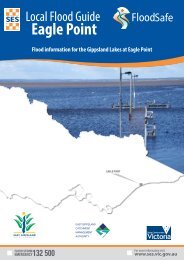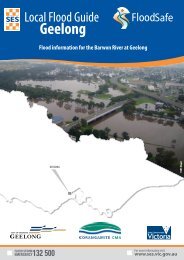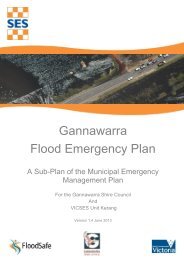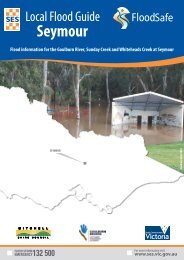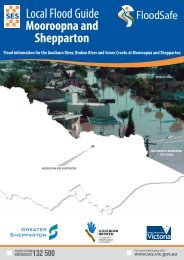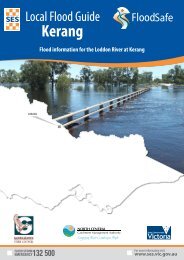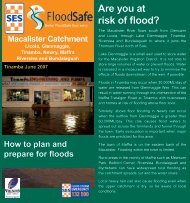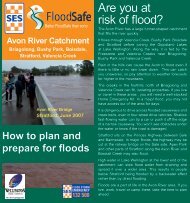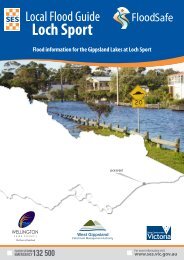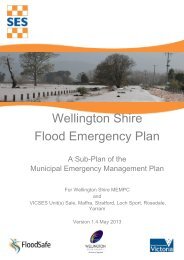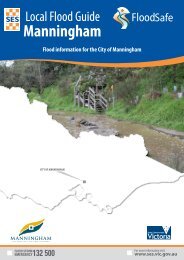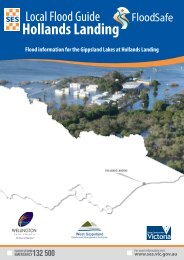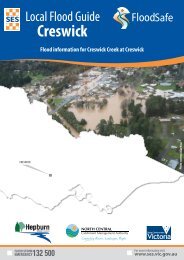Metung Local Flood Guide.pdf - Victoria State Emergency Service
Metung Local Flood Guide.pdf - Victoria State Emergency Service
Metung Local Flood Guide.pdf - Victoria State Emergency Service
Create successful ePaper yourself
Turn your PDF publications into a flip-book with our unique Google optimized e-Paper software.
What warnings mean<br />
About <strong>Flood</strong> WarningsAbout <strong>Flood</strong><br />
Warnings<br />
<strong>Flood</strong> Watches and <strong>Flood</strong> Warnings are issued by the Bureau of<br />
Meteorology (BoM) to tell people about possible flooding.<br />
A <strong>Flood</strong> Watch means there is a developing weather pattern that<br />
might cause floods.<br />
<strong>Flood</strong> Warnings mean flooding is about to happen or is already<br />
happening. For the Gippsland Lakes, <strong>Flood</strong> Warnings are generally<br />
issued after many days of flooding in communities such as<br />
Traralgon, Sale, Stratford and Bairnsdale and before flooding in<br />
the communities around the Gippsland Lakes begins.<br />
A <strong>Flood</strong> Warning provides predictions of flood impact and the<br />
estimated time before the lake levels will reach particular levels<br />
at gauges around the Lakes and how long it will be before the<br />
waters will recede.<br />
A Minor <strong>Flood</strong> Warning means:<br />
■■<br />
Lake levels start to flood waterside car parks and boat ramps<br />
■■<br />
Puddling will occur on and beside low lying roads and<br />
properties<br />
■■<br />
Storm water drains will start to flood internal roadways and<br />
properties<br />
■■<br />
Caravan parks may start to flood<br />
■■<br />
Some local low-lying roads will start to flood.<br />
A Major <strong>Flood</strong> Warning means:<br />
■■<br />
Lake levels have risen and cause extensive flooding in the<br />
towns and on lakeside farmland<br />
■■<br />
Residential and commercial properties are flooded<br />
■■<br />
Major traffic routes will be closed<br />
■■<br />
Properties and towns will be isolated<br />
■■<br />
Numerous evacuations may be required.<br />
Remember, you may not receive any official warning.<br />
<strong>Emergency</strong> assistance may not be immediately available. Be<br />
aware of what is happening around you to stay safe.<br />
Never wait for a warning to act.<br />
<strong>Emergency</strong> Alert<br />
SES may provide alerts to the <strong>Metung</strong> community through the<br />
<strong>Emergency</strong> Alert telephone warning system. All <strong>Emergency</strong><br />
<strong>Service</strong>s can use <strong>Emergency</strong> Alert to warn communities about<br />
dangerous situations by voice message to landline telephones or<br />
text message to mobile phones.<br />
If you receive a warning, make sure that all family members,<br />
people at work and your neighbours are aware of the situation.<br />
If you receive an <strong>Emergency</strong> Alert you should pay attention<br />
and act. It could mean life or death.<br />
If you need help to understand a warning, ask a friend, neighbour<br />
or family member.<br />
Warnings for <strong>Metung</strong><br />
For the Gippsland Lakes, <strong>Flood</strong> Warnings are issued by the Bureau<br />
of Meteorology. <strong>Flood</strong> Warnings provide predictions of flood size,<br />
time and possible peaks of the Gippsland Lakes.<br />
It is important to know how the predicted flood levels are likely<br />
to impact you as you may be affected before the peak, see page 3:<br />
Gippsland Lakes flood levels at <strong>Metung</strong> Marina Gauge.<br />
Use this table to figure out when you need to start following your<br />
flood emergency plan.<br />
The <strong>Victoria</strong> <strong>State</strong> <strong>Emergency</strong> <strong>Service</strong> (SES) will give information<br />
about how the floodwater might affect people and properties.<br />
This includes safety messages to remind you what to do.<br />
Severe Thunderstorm Warnings<br />
Thunderstorms are classified as severe, due to their potential to<br />
cause significant localised damage through: wind gusts, large hail,<br />
tornadoes or flash flooding. Severe thunderstorm warnings are<br />
issued to the community by the Bureau of Meteorology.<br />
Severe Weather Warnings<br />
These warnings are issued to the community by the Bureau of<br />
Meteorology when severe weather is expected that is not directly<br />
related to severe thunderstorms or bushfires. Examples of severe<br />
weather include damaging winds and flash flooding.<br />
<strong>Metung</strong> hotel, 2007 flood<br />
Flash <strong>Flood</strong>ing happens quickly. There may be little or no<br />
warning. The arrival time or depth of a flash flood can usually not<br />
be predicted.<br />
4<br />
<strong>Local</strong> <strong>Flood</strong> <strong>Guide</strong>




